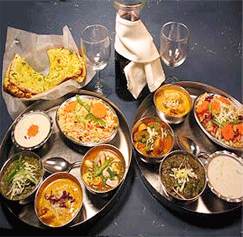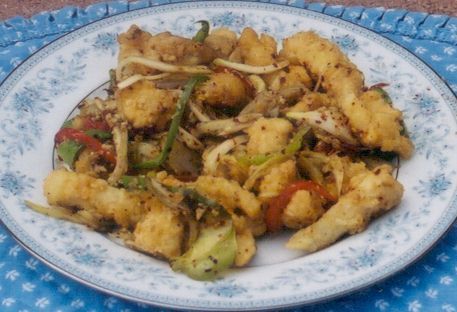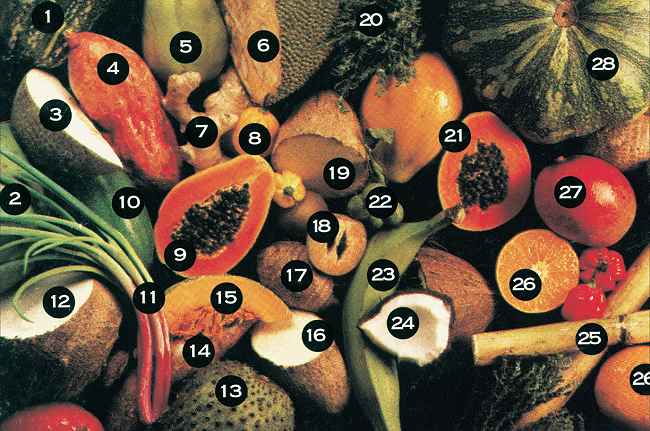|
 |
 |
|
Indian recipes

|
| |
The multiple families of Indian cuisine are characterized by their sophisticated and subtle use of many spices and herbs.
Arguably considered to be the world's most diverse cuisine, each family of this cuisine is characterized by a wide assortment
of dishes and cooking techniques. Though a significant portion of Indian food is vegetarian, many traditional Indian dishes
also include chicken, goat, lamb, fish, and other meats.
Food is an important part of Indian culture, playing a role in everyday life as well as in festivals. In many families,
everyday meals are usually sit-down affairs consisting of two to three main course dishes, varied accompaniments such as chutneys
and pickles, carbohydrate staples such as rice and roti (bread), as well as desserts.
Diversity is a defining feature of India's geography, culture, and food. Indian cuisine varies from region to region, reflecting
the varied demographics of the ethnically diverse subcontinent. Generally, Indian cuisine can be split into four categories:
North Indian, South Indian, East Indian, and West Indian. Despite this diversity, some unifying threads emerge in the art
of Indian cuisine. Varied uses of spices are an integral part of food preparation, and are used to enhance the flavor of a
dish and create unique flavors and aromas. Cuisine across India has also been influenced by various cultural groups that entered
India throughout history, from regions as diverse as West Asia, Central Asia and Europe.
|
|
|
 |
 |
 |
 |
|

|
| |
Food is an important part of daily life for Chinese
people. Chinese not only enjoy eating but believe eating good food can bring harmony and closeness to the family and relationships.
Shopping daily for fresh food is essential for all Chinese Cooking. Unlike the fast food society of the U.S., the Chinese
select live seafood, fresh meats and seasonal fruits and vegetables from the local market to ensure freshness. This means
swimming fish, snappy crabs, and squawking chickens. Even prepared foods such as dim sum or BBQ duck for to go orders must
gleam, glisten, and steam as if just taken out of the oven.
Chinese people in general are not as concerned about
nutrition as Western culture. They are more concerned with the food's texture, flavor, color, and aroma. These are the crucial
points for good Chinese cooking. Chinese daily meals consist of four food groups: grains, vegetables, fruit, and meat. Because
of lactose intolerance, Chinese do not consume large amounts of dairy products. Instead, Chinese substitute these with soymilk
and tofu, which also contain large amounts of protein and calcium. Vegetables, fruits, and meats are usually fresh. Some exceptions
include preserved vegetables such as snow cabbage or mustard greens, preserved eggs, aka "thousand year old eggs" or salted
and dried fish. Other exceptions include snack items such as beef jerky, cuttlefish jerky, sweet and sour preserved plums,
or dehydrated mango slices.
|
|
|
 |
 |
|
 |
 |
|
|
Contrary to popular belief outside of Mexico, the cuisine
of this sunny country is rich in history, flavour, contrast, texture and colour. Mexicans, particularly the well-to-do ones
eat a varied diet of fresh meats, fish, shellfish, fowl, vegetables and fruits.
Most foods are field fresh due to necessity,
and never older than two days. They taste as nature intended. Pesticide and herbicide use is minimal due to cost considerations,
and both fruits and vegetables are picked ripe or very close to ripeness. Of course, Mexicans eat only seasonal fruits and
vegetables, never dreaming to look for anything out of season, or imported from thousands of kilometres away.
Almost everything
is consumed locally, expect in Mexico City where producers ship the goods that are unlikely to sell locally
|
|

The region of UAE is a superb place to taste the finest of all kinds of Gulf and Middle Eastern food which include Iranian,
Moroccan as well as Lebanese cuisines. The Arabian cuisine in UAE reflects the diversity that is embedded in its culture.
The fact that the UAE has traditionally been a center for all types of trades since time immemorial now has accounted for
an enormous variety of tastes. There is a massive selection of food that is imported as well as locally produced, which makes
the region an excellent place for a great culinary experience. Arabic and Middle Eastern food chiefly dominates the overall
of cuisine of the region. Majority of the restaurants in UAE serve Lebanese food. It can be a tedious task sometimes to find
a restaurant that serves authentic UAE meals, nevertheless the cuisine of UAE is filled with abundant delicacies of all types.
One distinctive flavor of the Gulf region’s cuisine is that of the dried lime; grown in Oman or commonly imported from
Southeast Asia and dried on trees. This particular ingredient is common in the cuisine of the region. [edit]Cuisines of United
Arab Emirates
Map of United Arab Emirates- Click to enlargeAs the region is quite diverse, therefore it is not surprising
to see that the cuisine of Arabia is also quite diverse and come in a lot of variety. Many of the dishes that you will find
in the Arabian cuisine are prepared from meat, rice, Wheat, vegetables and a whole lot of spices. The cuisine of Arabia is
a mixture of a lot of other cultures. Therefore, you will most definitely find a taste of the Lebanese, Turkish etc. taste
in the Arabian cuisine.
Rice is an integral part of the Arabian cuisine. Many of the dishes in the cuisine of Arabia use dried fruits in them
as well. The local dishes such as Macthbous, which is spiced Lamb served with rice, Hareis, a rich delicacy of slow cooked
Wheat along with tender Lamb meat and seafood served with seasoned rice, are very popular dishes in the cuisine of Arabia.
A traditional Middle Eastern snack is the shawarma - grilled slice of Lamb or Chicken, mixed with salad and rolled inside
a pocket of the traditonal Arabic bread. This snack is quite popular not only in the Arabian region but has also gained a
lot of international popularity, as you are quite likely to find this snack in a lot of countries in the present day. All
in all the cuisine of Arabia is unique and diverse.
|
|

The dining options of the Caribbean are indicative of the area's diverse cultures. In fact, the Caribbean's food mirrors
the personality of the region itself.
A blend of ethnic influences, Caribbean food is a rich reminder of where today's
Caribbean people came from: island food brings together indigenous tastes of the native Arawak and Carib Indians, European
colonial influences, and African flavors introduced by slaves.
Seafood is a natural specialty of the islands, but the
Caribbean's rich soil bears many treats as well. The end result is an enticing Creole mix that is one of the most widespread
cultural exports of the Caribbean. Indeed, the innovative cuisine of the West Indies is enjoyed all over the world.
One
of the most interesting aspects of Caribbean dining is the ability to try it all: Grab a bite at a small mom-and-pop, or dress
to the nines for a night out. The next night you can try something different. And, of course, the foods will differ from island
to island as well. From the savory spices of Latin cuisines to the stylish French fare, you're sure to find something different
every night.
|
|
 |
 |
|